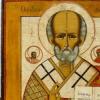Religious views and ideas. The role of religion in human life and society
Faith in God surrounds a person from infancy. In childhood, this still unconscious choice is associated with family traditions that exist in every home. But later a person can consciously change his religion. How are they similar and how are they different from each other?
The concept of religion and the prerequisites for its appearance
The word “religion” comes from the Latin religio (piety, sacredness). This is an attitude, behavior, actions based on faith in something that surpasses human understanding and is supernatural, that is, sacred. The beginning and meaning of any religion is faith in God, regardless of whether he is personified or impersonal.
There are several known preconditions for the emergence of religion. Firstly, from time immemorial man has been trying to go beyond the boundaries of this world. He strives to find salvation and consolation beyond his borders and sincerely needs faith.
Secondly, a person wants to give an objective assessment of the world. And then, when he cannot explain the origin of earthly life only by natural laws, he makes the assumption that a supernatural force is attached to all this.
Thirdly, a person believes that various events and incidents of a religious nature confirm the existence of God. The list of religions for believers already serves as real proof of the existence of God. They explain this very simply. If God did not exist, there would be no religion.
The most ancient types, forms of religion
The origin of religion occurred 40 thousand years ago. It was then that the emergence of the simplest forms of religious beliefs was noted. It was possible to learn about them thanks to the discovered burials, as well as rock and cave paintings.
In accordance with this, the following types of ancient religions are distinguished:
- Totemism. A totem is a plant, animal or object that was considered sacred by one or another group of people, tribe, clan. The basis of this ancient religion was the belief in the supernatural power of the amulet (totem).
- Magic. This is a form of religion based on belief in human magical abilities. With the help of symbolic actions, a magician is able to influence the behavior of other people, natural phenomena and objects from a positive and negative side.
- Fetishism. From among any objects (an animal or human skull, a stone or a piece of wood, for example), one was selected to which supernatural properties were attributed. It was supposed to bring good luck and protect from danger.
- Animism. All natural phenomena, objects and people have a soul. She is immortal and continues to live outside the body even after its death. All modern types of religions are based on the belief in the existence of souls and spirits.
- Shamanism. The tribal leader or priest was believed to have supernatural powers. He entered into conversation with the spirits, listened to their advice and fulfilled their demands. Belief in the power of the shaman is at the core of this form of religion.

List of religions
There are more than a hundred different religious movements in the world, including ancient forms and modern movements. They have their own time of occurrence and differ in the number of followers. But at the heart of this large list are the three most numerous world religions: Christianity, Islam and Buddhism. Each of them has different directions.
 World religions in the form of a list can be presented as follows:
World religions in the form of a list can be presented as follows:
1. Christianity (almost 1.5 billion people):
- Orthodoxy (Russia, Greece, Georgia, Bulgaria, Serbia);
- Catholicism (Western European countries, Poland, Czech Republic, Lithuania and others);
- Protestantism (USA, UK, Canada, South Africa, Australia).
2. Islam (about 1.3 billion people):
- Sunnism (Africa, Central and South Asia);
- Shiism (Iran, Iraq, Azerbaijan).
3. Buddhism (300 million people):
- Hinayana (Myanmar, Laos, Thailand);
- Mahayana (Tibet, Mongolia, Korea, Vietnam).
National religions
In addition, in every corner of the world there are national and traditional religions, also with their own directions. They originated or became particularly widespread in certain countries. On this basis, the following types of religions are distinguished:
- Hinduism (India);
- Confucianism (China);
- Taoism (China);
- Judaism (Israel);
- Sikhism (Punjab state in India);
- Shintoism (Japan);
- paganism (Indian tribes, peoples of the North and Oceania).
Christianity
This religion originated in Palestine in the Eastern part of the Roman Empire in the 1st century AD. Its appearance is associated with faith in the birth of Jesus Christ. At the age of 33, he suffered martyrdom on the cross to atone for human sins, after which he was resurrected and ascended to heaven. Thus, the son of God, who embodied supernatural and human nature, became the founder of Christianity.
The documentary basis of the doctrine is the Bible (or Holy Scripture), consisting of two independent collections of the Old and New Testaments. The writing of the first of them is closely related to Judaism, from which Christianity originates. The New Testament was written after the birth of religion.
 Symbols of Christianity are the Orthodox and Catholic cross. The main provisions of faith are defined in dogmas, which are based on faith in God, who created the world and man himself. Objects of worship are God the Father, Jesus Christ, the Holy Spirit.
Symbols of Christianity are the Orthodox and Catholic cross. The main provisions of faith are defined in dogmas, which are based on faith in God, who created the world and man himself. Objects of worship are God the Father, Jesus Christ, the Holy Spirit.
Islam
Islam, or Islam, originated among the Arab tribes of Western Arabia at the beginning of the 7th century in Mecca. The founder of the religion was the Prophet Muhammad. This man was prone to loneliness from childhood and often indulged in pious reflections. According to the teachings of Islam, at the age of 40, the heavenly messenger Jabrail (Archangel Gabriel) appeared to him on Mount Hira, who left an inscription in his heart. Like many other world religions, Islam is based on belief in one God, but in Islam he is called Allah.
 Holy Scripture - Koran. The symbols of Islam are the star and crescent. The main provisions of the Muslim faith are contained in dogmas. They must be recognized and unquestioningly implemented by all believers.
Holy Scripture - Koran. The symbols of Islam are the star and crescent. The main provisions of the Muslim faith are contained in dogmas. They must be recognized and unquestioningly implemented by all believers.
The main types of religion are Sunnism and Shiism. Their appearance is associated with political disagreements between believers. Thus, Shiites to this day believe that only the direct descendants of the Prophet Muhammad carry the truth, while Sunnis think that this should be a chosen member of the Muslim community.
Buddhism
Buddhism originated in the 6th century BC. Its homeland is India, after which the teaching spread to the countries of Southeast, South, Central Asia and the Far East. Considering how many other most numerous types of religions exist, we can safely say that Buddhism is the most ancient of them.
The founder of the spiritual tradition is Buddha Gautama. This was an ordinary person, whose parents were awarded the vision that their son would grow up to be a Great Teacher. The Buddha was also lonely and brooding, and very quickly turned to religion.
There is no object of worship in this religion. The goal of all believers is to achieve nirvana, a blissful state of insight, to free themselves from their own shackles. Buddha for them represents a certain ideal that should be equaled.
 At the heart of Buddhism is the teaching of the Four Noble Truths: about suffering, about the origin and causes of suffering, about the true cessation of suffering and the elimination of its sources, about the true path to the cessation of suffering. This path consists of several steps and is divided into three stages: wisdom, morality and concentration.
At the heart of Buddhism is the teaching of the Four Noble Truths: about suffering, about the origin and causes of suffering, about the true cessation of suffering and the elimination of its sources, about the true path to the cessation of suffering. This path consists of several steps and is divided into three stages: wisdom, morality and concentration.
New religious movements
In addition to those religions that originated a long time ago, new faiths still continue to appear in the modern world. They are still based on faith in God.
The following types of modern religions can be noted:
- Scientology;
- neo-shamanism;
- neopaganism;
- Burkhanism;
- neo-Hinduism;
- Raelites;
- oomoto;
- and other currents.
This list is constantly modified and supplemented. Some types of religions are especially popular among show business stars. For example, Tom Cruise, Will Smith, and John Travolta are seriously interested in Scientology.
 This religion arose in 1950 thanks to science fiction writer L. R. Hubbard. Scientologists believe that every person is inherently good, his success and peace of mind depend on himself. According to the fundamental principles of this religion, people are immortal beings. Their experience lasts longer than one human life, and their abilities are unlimited.
This religion arose in 1950 thanks to science fiction writer L. R. Hubbard. Scientologists believe that every person is inherently good, his success and peace of mind depend on himself. According to the fundamental principles of this religion, people are immortal beings. Their experience lasts longer than one human life, and their abilities are unlimited.
But everything is not so simple in this religion. In many countries it is believed that Scientology is a sect, a pseudo-religion with a lot of capital. Despite this, the trend is very popular, especially in Hollywood.
Religion is a certain worldview that seeks to understand the higher mind, which is the root cause of everything that exists. Any belief reveals to a person the meaning of life, his purpose in the world, which helps him find a goal, and not an impersonal animal existence. There have always been and will be many different worldviews. Thanks to the eternal human search for the root cause, the religions of the world were formed, the list of which is classified according to two main criteria:
How many religions are there in the world?
The main world religions are Islam and Buddhism, each of which is divided into numerous large and small branches and sects. It is difficult to say how many religions, beliefs and convictions there are in the world, due to the regular creation of new groups, but according to some information, there are thousands of religious movements at the present stage.
World religions are called so because they have gone far beyond the borders of the nation, country, and have spread to a huge number of nationalities. Those who are not worldly confess within a smaller number of people. The monotheistic view is based on the belief in one God, while the pagan view assumes the existence of several deities.
The world's largest religion, which arose 2,000 years ago in Palestine. It has about 2.3 billion believers. In the 11th century there was a division into Catholicism and Orthodoxy, and in the 16th century Protestantism also separated from Catholicism. These are three large branches, there are more than a thousand other small ones.
The basic essence of Christianity and its distinctive features from other religions are as follows:
Orthodox Christianity has adhered to a tradition of faith since apostolic times. Its foundations were formulated by the Ecumenical Councils and dogmatically enshrined in the Creed. The teaching is based on Holy Scripture (mainly the New Testament) and Holy Tradition. Divine services are performed in four circles, depending on the main holiday - Easter:
- Daily.
- Sedmichny.
- Mobile annual.
- Fixed annual.
In Orthodoxy there are seven main Sacraments:
- Baptism.
- Confirmation.
- Eucharist (Communion of the Holy Mysteries of Christ).
- Confession.
- Unction.
- Wedding.
- Priesthood.
In the Orthodox understanding, God is one in three persons: Father, Son, Holy Spirit. The Ruler of the world is interpreted not as an angry avenger for the misdeeds of people, but as a Loving Heavenly Father, caring for his creation and bestowing the grace of the Holy Spirit in the Sacraments.
Man is recognized as the image and likeness of God, with free will, but fallen into the abyss of sin. The Lord helps those who want to restore their former holiness and get rid of passions on this path.
Catholic teaching is a major movement in Christianity, widespread mainly in Europe, Latin America and the USA. This doctrine has much in common with Orthodoxy in its understanding of God and the relationship between the Lord and man, but there are fundamental and important differences:
- the infallibility of the head of the church, the Pope;
- The Holy Tradition is formed from 21 Ecumenical Councils (the first 7 are recognized in Orthodoxy);
- the distinction between the clergy and the laity: people in the rank are endowed with Divine Grace, they are assigned the role of shepherds, and the laity - the herd;
- the doctrine of indulgences as a treasury of good deeds performed by Christ and the Saints, and the Pope, as the vicar of the Savior on earth, distributes forgiveness of sins to whomever wants and who needs it;
- adding your understanding to the dogma of the Holy Spirit proceeding from the Father and the Son;
- introducing dogmas about the immaculate conception of the Virgin Mary and Her bodily ascension;
- the doctrine of purgatory as the average state of the human soul, cleansed of sins as a result of difficult trials.
There are also differences in the understanding and performance of some Sacraments:
It arose as a result of the Reformation in Germany and spread throughout Western Europe as a protest and desire to transform the Christian Church, getting rid of medieval ideas.
Protestants agree with Christian ideas about God as the Creator of the world, about human sinfulness, about the eternity of the soul and salvation. They share the understanding of hell and heaven, while rejecting Catholic purgatory.
Distinctive features of Protestantism from Catholicism and Orthodoxy:
- minimizing church sacraments - until Baptism and Communion;
- there is no division between clergy and laity, every well-prepared person in matters of Holy Scripture can be a priest for himself and for others;
- the service is held in the native language and is based on joint prayer, reading psalms, and sermons;
- there is no veneration of saints, icons, relics;
- monasticism and the hierarchical structure of the church are not recognized;
- salvation is understood only by faith, and good works will not help to justify oneself before God;
- recognition of the exclusive authority of the Bible, and each believer interprets the words of Scripture at his own discretion, the criterion being the point of view of the founder of the church organization.
The main directions of Protestantism: Quakers, Methodists, Mennonites, Baptists, Adventists, Pentecostals, Jehovah's Witnesses, Mormons.

The world's youngest monotheistic religion. The number of believers is about 1.5 billion people. The founder is the prophet Muhammad. Holy book - Koran. For Muslims, the main thing is to live according to the prescribed rules:
- pray five times a day;
- observe the fast of Ramadan;
- give alms 2.5% per year of income;
- make a pilgrimage to Mecca (Hajj).
Some researchers add a sixth duty of Muslims - jihad, which manifests itself in the struggle for faith, zeal, and diligence. There are five types of jihad:
- internal self-improvement on the path to God;
- armed struggle against non-believers;
- struggle with your passions;
- separation of good and evil;
- taking action against criminals.
Currently, extremist groups use jihad of the sword as an ideology to justify their murderous activities.
A world pagan religion that denies the existence of the Divine. Founded in India by Prince Siddhartha Gautama (Buddha). Briefly summarized by the teaching of the Four Noble Truths:
- All human life is suffering.
- Desire is the cause of suffering.
- To overcome suffering, you need to get rid of desire with the help of a specific state - nirvana.
- To free yourself from desire, you need to follow eight basic rules.
According to the teachings of the Buddha, acquiring a calm state and intuition and clearing the mind will help:
- a correct understanding of the world as a lot of suffering and sorrow;
- acquiring a firm intention to curtail your wishes and aspirations;
- control of speech, which should be friendly;
- performing virtuous actions;
- trying not to harm living beings;
- expulsion of evil thoughts and a positive attitude;
- the realization that human flesh is evil;
- perseverance and patience in achieving the goal.
The main branches of Buddhism are Hinayana and Mahayana. Along with it, there are other religions in India, widespread to varying degrees: Hinduism, Vedism, Brahmanism, Jainism, Shaivism.
What is the oldest religion in the world?
The ancient world was characterized by polytheism (polytheism). For example, Sumerian, ancient Egyptian, Greek and Roman religions, Druidism, Asatru, Zoroastrianism.
One of the ancient monotheistic beliefs is Judaism - the national religion of the Jews, based on the 10 commandments given to Moses. The main book is the Old Testament.
Judaism has several branches:
- Litvaks;
- Hasidism;
- Zionism;
- orthodox modernism.
There are also different types of Judaism: Conservative, Reform, Reconstructionist, Humanistic and Renovationist.
Today it is difficult to give a definite answer to the question “What is the oldest religion in the world?”, since archaeologists regularly find new data to confirm the emergence of different worldviews. We can say that beliefs in the supernatural have been inherent in humanity at all times.
The huge diversity of worldviews and philosophical beliefs since the emergence of mankind does not make it possible to list all the religions of the world, the list of which is regularly updated with both new movements and branches from already existing world and other beliefs.
You've probably heard the expression “Intention is half the battle.” On this occasion, 26-year-old Iranian Said Qasemi, who has achieved success in life, addressing his young friends, says: “If you cannot be an oak tree on the top of a hill, be a bush on the hillside, but the best bush on the whole path. If you can’t be a bush, be grass, but green enough to show off from afar. Maybe you won't become the sun, at least be a bright star. The main thing in this world is to have some role, small or large. The main thing is to benefit society.” According to psychologists, the period of maturation and coming of age among young people is accompanied by a flourishing of religious feelings, a desire for faith and ethical standards. According to Maurice Debs:
“At this time, the so-called religious conscience awakens in young people who previously had no interest in religion, and this transformation is an integral part of the development of a person’s personality. From 15 to 17 years old, young people hear the voice of this holy conscience and begin to become bolder. They dream of creating a new world, of destroying evil and establishing the absolute power of justice.”
The tendency towards religious virtues culminates in early youth, especially in more religious societies. People at this age gravitate toward kindness and sincerity. To the point that sometimes teenagers get carried away with self-torture, engage in worship, communion with God day and night, refuse simple pleasures, thus developing extraordinary purity and piety in their souls. They strive to base all their endeavors on goodness, kindness and sincerity.
Young people are naturally curious and want to gain knowledge about religion, the Universe and its Creator. The 30th verse of Surah Rumah in the Holy Quran says:
“Turn your face to religion with fidelity according to the decree of Allah, which he prescribed for people. What Allah has created cannot be changed.”
Religious feeling is associated with a kind of inner peace and pleasure. Many young people feel this way. Of course, religious and spiritual pleasures are different from other pleasures in life. Receiving ordinary pleasure, when a person achieves his goal, some kind of satiety and reluctance arises in him, while receiving spiritual pleasure, a person wants it more and more.
On the other hand, during this same period, young people have ideological doubts and hesitations, which can sometimes turn on the horizon of a young man’s life like a comet and change his whole life. This is exactly what happened to the European woman who converted to Islam, Mrs. Marie, who chose the name Fatima. Having experienced some kind of duality and ideological contradiction for a long time, she now happily says: “After much study and research, I came to my cherished ideal.
One fine evening, when I was visiting my Muslim friends, I admired their sincere, spiritual company. There I experienced a transformation in myself after hearing the enchanting melody of the Koran. The attractive verses of revelation revealed to me a new meaning of life. It was as if I had emerged from my snail’s labyrinth of life into some brighter and more illuminated world. My whole being was filled with indescribable jubilation. The truth opened a window into the world of beauty for me.”
Experts emphasize the fact that when a young person finds himself in a healthy educational environment, away from the barrage of information and brainwashing, religious feelings are sure to awaken in him. American psychologist Rogers believes: “When people move away from religion, they develop a negative mentality, so that they are unable to get along with themselves, much less with others. However, these same people, when turning to religion, are much more willing, with much greater flexibility, to recognize themselves and others.”
Regarding the role of religion in the formation of young people, the World Health Organization in a recent report emphasizes that adherence to religion is one of the main factors in preventing suicide.
Professor Muhammadi of the University of Tehran, speaking at a forum on this topic, noted:
“Despite the fact that today's youth are surrounded by satellite broadcasting, the Internet and all kinds of film products, many young people remain faithful to their religious beliefs. Of course, their views on faith may be somewhat different from the attitude towards religion of their fathers and mothers.”
In choosing the right course in life, young people constantly need lofty standards that serve as guides on their path. However, you should show special tact and approach the issue extremely thoughtfully. Young people need to be kindly, based on logic and common sense, encouraged to think correctly and to worthy endeavors, so that they take the right path of their own free will, and not under coercion. Forced hammering of religious concepts often backfires.
His Lordship Imam Ali (peace be upon him) says:
“The nature of hearts is built on request, kindness and friendliness. Therefore, treat it tenderly, for whenever the heart does something under compulsion, it becomes blind and hardened and does everything wrong.”
Young people are yearning for a brighter, greener environment in which they hope to leave behind a monotonous lifestyle. Religious teachings, on the one hand, satisfy their religious feelings and needs, and on the other, intelligently curb their natural, instinctive drives, preventing them from turning into rebels and outcasts. It should not be forgotten that family and society play a very important role in strengthening religious beliefs in a young soul.
Research by two European researchers, Cochlan and Arnold, shows that teenagers between the ages of 12 and 15 are most inclined towards religion. Around the age of 18, under the negative influence of the environment and often due to the carelessness of the family, religious feelings become dull. Therefore, if even in adolescence the shoots of faith sprout in the soul, over time they must be persistently nourished and watered.
In this regard, the leaders of Islam also constantly called for the correct teaching and upbringing of religious teachings and ethical values even in early youth.
Imam Sadiq (peace be upon him) says:
“A young believer who reads the Koran absorbs it with every fiber of his soul, so that the Koran penetrates into the depths of his consciousness.”
According to the words of the Prophet of Islam (may Allah bless him and his family), on the day of the Last Judgment Allah will bestow special mercy on two groups of people: the first includes just rulers, and the second - young people who have been educated in the bosom of worship.
What is the role of religion in the life of each individual and society as a whole is a question that many philosophers have been pondering over, from ancient times to the present day. How do religious views change over time? Or do they remain unchanged?
Do the achievements of scientists, the benefits of civilization, changes in lifestyle, activities and needs of people influence religious ideas? What is it like to be a believer today? All these and many other questions arise not only among philosophers or students, but also among those who want to understand whether in the modern world there is still a place for faith in God or not.
What is religion?
Religion is a set of views, worldview, and feelings based on absolute faith in something supernatural. In addition to certain emotional manifestations and ways of thinking, it also includes social and managerial functions, and is also an integral part of people’s culture.
Due to the versatility of this phenomenon, religion has several definitions. The main ones are:
- a form of social consciousness, which is based on combinations of beliefs and views that arose due to faith in the same supernatural force;
- a variant of organizing relationships between people, characterized by its own rules, traditions, ethical standards and other characteristics inherent in society;
- spiritual essence is a special type of a person’s vision of himself, his own personality and the value of life, the world around him, everyday life and other things.
It is impossible to give an exact and unambiguous definition of such a phenomenon as religion. It directly depends on which particular aspect of it is being considered.
Can religion be classified?
Religious views, without a doubt, relate to a person's specific religion. However, regardless of the nuances that are given to this phenomenon by a particular religion, there is also a general division into two large types.
According to this division, each religion can belong to two types:
- objective general;
- personal.
The subjective, personal type is a person’s individual religious views, his direct perception of God. That is, this type refers to everything that relates to personal thoughts and feelings associated with religion. For example, exactly how a person prefers to pray, which saints he turns to, whether he goes to a large church or a small one - these are elements of the manifestation of religiosity, classified as a subjective type. Of course, what a particular person thinks about God, the degree of his faith, and other things that relate to thinking are also included in the concept of a subjective type of religiosity.
The objective, or general type, includes all those characteristics that relate to religion as an institution, social and cultural phenomenon. That is, this type includes the formation of social consciousness, traditions, norms of morality and behavior accepted in society, and much more. Everything that unites people and is common to them can be included in the objective type of religiosity.
What does the word itself mean? How and where did it appear?
Religion is a word whose origin and exact meaning have been debated since ancient times. For example, Cicero believed that the term “religio” was formed from one of the Latin verbs, namely “relegere”.
The word “religio” is translated into Russian as follows:
- object of worship, cult;
- piety, belief;
- piety.
One of the meanings of this term is conscientiousness, conditioned by the traditions and ideas of the professed faith.
The verb "relegere" has the following meaning:
- "collect again";
- "to reconnect";
- "to bind";
- "special use"
It is impossible to accurately translate this word; there is no analogue in the Russian language, for all its richness. The most accurate meaning in the context of religion is considered to be “to communicate with the Highest,” that is, to belong to some cult.
Lactantius and Augustine shared Cicero's point of view, interpreting religion as the connection between man and God. In other words, the lights defined the meaning of the term “religion” as a connection or reunion, a merging of man and God.
In Sanskrit, a related term is the word "dharma". Its meaning can be conveyed like this:
- order of the universe;
- the doctrine of the highest;
- law of being;
- sample, standard of lifestyle.
In Islamic cultures, the term "din" corresponds to religion. Its main semantic difference is that the main meaning is “subordination.” It is about man's submission to the will of God.

Every language or culture has a term similar to the word "religion". Of course, there are differences in the subtleties and nuances of meaning, but the general meaning is the same.
In Russian, the term “religion” has been used only since the 18th century. Before this, their own Slavic expressions were in use, for example, the word “faith”.
What is the role of religion in life?
The role of religion in human life and society is diverse; its functions apply to literally all spheres. Religion influences how individuals and society as a whole act in certain circumstances.
For example, when faced with theft or violence, a Christian will act differently than a Muslim. At the same time, neither one nor the other will think about their actions, they will act intuitively. Thus, one of the roles of religion in people’s lives is the formation of mentality, characteristics, stereotypes of perception and behavior.
Another example of how religious ideas influence people and social consciousness are traditional norms regarding appearance, behavior and lifestyle, family structure and everyday life. Moreover, they often exist in parallel with a completely different perception of reality. For example, divorce is still a terrible problem for Catholics and is not approved by the church. This phenomenon is treated the same way in Orthodoxy. Along with this, in secular relationships between people this is an absolutely normal event that does not become a shame or stigma. Developing the topic of marriage, it should be noted that in different religions the relationships between people are not the same. Mormons believe in Christ, but polygamy is practiced in their society. Catholicism requires people to choose a single partner and be faithful to him.
Thus, religion dictates what is considered normal in society. This is her role. Modern realities do not change the fundamental foundation of social consciousness, ethics, norms accepted in society, but only complement and correct it.
This is clearly visible in the example of family organization. Christianity considers it normal to build relationships with one partner. And secular marriage registration in countries with Christian cultures is also carried out with one person. After all, it is impossible, for example, in Moscow or London to register an official family union with several partners at once. However, modern realities, in which individuals have many more opportunities, rights and freedoms than in ancient times, allow for the possibility of an official change of partner, that is, divorce.

But the main thesis of the norm for building a family, embedded in a person’s mentality by religion, does not change because of this. Family relationships with several partners are not officially built at the same time. Since the family is a unit of society and a miniature reflection of everything that is accepted in it, then, based on this example, conclusions can be drawn regarding other processes inherent in society.
Thus, the role of religion in the life of society and individuals can be defined as fundamental, forming norms, traditions, rules and mentality, influencing behavior, thinking, culture and relationships.
What are the functions of religion?
A person’s religious views shape his behavior, attitude towards the surrounding reality, and perception of reality.

We can identify the following main functions of religion for society:
- regulating;
- legitimizing;
- ideological.
Each of these functions has specific features, depending on what religious teachings form their basis.
About the ideological function
Forming a worldview is one of the most important social functions of religion. Various religious teachings in this context are nothing more than the primary system of human values, which take the form of unconditional reactions.
In other words, this is a semantic component of thinking, that is, a combination of views and stereotypes through which a person perceives objective reality. They form those traditions, rules and norms that characterize a certain society.
About the legitimizing function
The meaning of this term is legality, legality of something. In practice, this concept is expressed in restrictions on specific actions, actions and even thoughts. An example of a limitation of thought can be medieval religious education and other persecution of scientific activity.

In the modern world, this function comes down to observing religious commandments, which form the basis of the criminal law of any state. Most of them describe the books of the New Testament and other sacred ancient texts. These are prohibitions on murder, theft, adultery, debauchery and other similar actions.
About the regulatory function
In the context of this function, religion is perceived as an orientational, normative system that gives integrity to society.
In other words, religious relations become the foundation of secular relations in all spheres and areas of people’s life. They regulate even areas that are far from spirituality, for example, a typical diet. In countries with Muslim culture, it is impossible to find pork dishes on the menu of restaurants or cafes. In India, catering establishments will not serve beef salad.
That is, the regulatory function of religion lies in generally accepted standards and guidelines that every member of society follows.
What are religious centers?
This concept has several meanings. As a rule, it means the immediate place in which religious rituals are performed, that is, sanctuaries, temples, cathedrals, mosques, etc.
However, the concept of “religious centers” has other meanings. These are governing bodies, administrative entities that regulate spiritual work, determine its goals and actually lead church activities. An example of this is the Vatican - the religious center of Catholicism.

This term also refers to certain places in the world that are traditional for pilgrimage. For example, the monasteries of Athos or Jerusalem are places that many Christians strive to see.
What is the significance of religious views and ideas in the life of a modern person?
Despite the fact that religiosity is not the main feature of most modern people, they experience and demonstrate its influence almost constantly.

In the modern world, religiosity, religious ideas about the world order, views on relationships between people are a kind of stabilizing factor that gives solidity and meaning to everything that happens around.



















